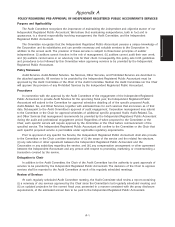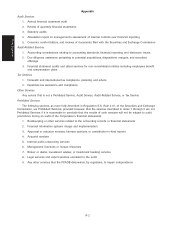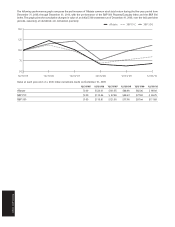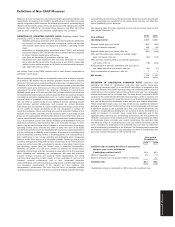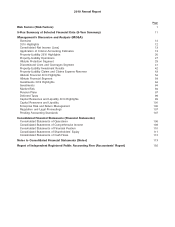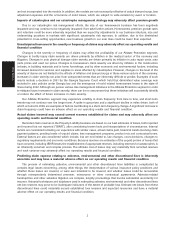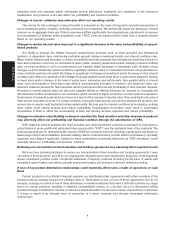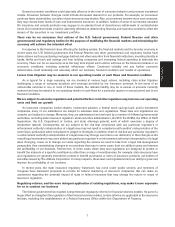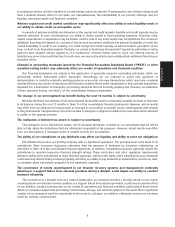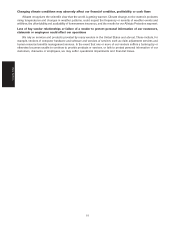Allstate 2011 Annual Report Download - page 83
Download and view the complete annual report
Please find page 83 of the 2011 Allstate annual report below. You can navigate through the pages in the report by either clicking on the pages listed below, or by using the keyword search tool below to find specific information within the annual report.
Regulation limiting rate increases and requiring us to underwrite business and participate in loss sharing
arrangements may adversely affect our operating results and financial condition
From time to time, political events and positions affect the insurance market, including efforts to suppress rates to a
level that may not allow us to reach targeted levels of profitability. For example, if Allstate Protection’s loss ratio
compares favorably to that of the industry, state regulatory authorities may impose rate rollbacks, require us to pay
premium refunds to policyholders, or resist or delay our efforts to raise rates even if the property and casualty industry
generally is not experiencing regulatory resistance to rate increases. Such resistance affects our ability, in all product
lines, to obtain approval for rate changes that may be required to achieve targeted levels of profitability and returns on
equity. Our ability to afford reinsurance required to reduce our catastrophe risk in designated areas may be dependent
upon the ability to adjust rates for its cost.
In addition to regulating rates, certain states have enacted laws that require a property-liability insurer conducting
business in that state to participate in assigned risk plans, reinsurance facilities and joint underwriting associations or
require the insurer to offer coverage to all consumers, often restricting an insurer’s ability to charge the price it might
otherwise charge. In these markets, we may be compelled to underwrite significant amounts of business at lower than
desired rates, possibly leading to an unacceptable return on equity, or as the facilities recognize a financial deficit, they
may in turn have the ability to assess participating insurers, adversely affecting our results of operations and financial
condition. Laws and regulations of many states also limit an insurer’s ability to withdraw from one or more lines of
insurance in the state, except pursuant to a plan that is approved by the state insurance department. Additionally,
certain states require insurers to participate in guaranty funds for impaired or insolvent insurance companies. These
funds periodically assess losses against all insurance companies doing business in the state. Our operating results and
financial condition could be adversely affected by any of these factors.
The potential benefits of our sophisticated risk segmentation process may not be fully realized
We believe that pricing sophistication and underwriting (including Strategic Risk Management which, in some
situations, considers information that is obtained from credit reports among other factors) has allowed us to be more
competitive and operate more profitably. However, because many of our competitors have adopted underwriting criteria
and sophisticated pricing models similar to those we use and because other competitors may follow suit, our
competitive advantage could decline or be lost. Further, the use of insurance scoring from information that is obtained
from credit reports as a factor in underwriting and pricing has at times been challenged by regulators, legislators,
litigants and special interest groups in various states. Competitive pressures could also force us to modify our pricing
sophistication model. Furthermore, we cannot be assured that these pricing sophistication models will accurately reflect
the level of losses that we will ultimately incur.
Allstate Protection’s operating results and financial condition may be adversely affected by the cyclical
nature of the property and casualty business
The property and casualty market is cyclical and has experienced periods characterized by relatively high levels of
price competition, less restrictive underwriting standards and relatively low premium rates, followed by periods of
relatively lower levels of competition, more selective underwriting standards and relatively high premium rates. A
downturn in the profitability cycle of the property and casualty business could have a material adverse effect on our
operating results and financial condition.
Risks Relating to the Allstate Financial Segment
Changes in underwriting and actual experience could materially affect profitability and financial condition
Our product pricing includes long-term assumptions regarding investment returns, mortality, morbidity, persistency
and operating costs and expenses of the business. We establish target returns for each product based upon these
factors and the average amount of capital that we must hold to support in-force contracts taking into account rating
agencies and regulatory requirements. We monitor and manage our pricing and overall sales mix to achieve target new
business returns on a portfolio basis, which could result in the discontinuation or de-emphasis of products or
distribution relationships and a decline in sales. Profitability from new business emerges over a period of years
depending on the nature and life of the product and is subject to variability as actual results may differ from pricing
assumptions. Additionally, many of our products have fixed or guaranteed terms that limit our ability to increase
revenues or reduce benefits, including credited interest, once the product has been issued.
Our profitability in this segment depends on the adequacy of investment spreads, the management of market and
credit risks associated with investments, the sufficiency of premiums and contract charges to cover mortality and
morbidity benefits, the persistency of policies to ensure recovery of acquisition expenses, and the management of
3
Risk Factors


